Professional Mold Remediation Services
Don't Let Toxic Mold Put Your Family's Health at Risk
Stop mold damage before it spreads. Call now for a free, no-obligation estimate from a local remediation expert.
Free Estimate · Zero Obligation · Available 24/7
Mold on Roof Trusses
One of the most contradicting topics in the mold industry is mold on roof trusses. The framing lumber that is an integral part of holding the roof decking in place is typically always made of lumber.
And as we know, wood is porous and can support mold growth.
But is it a big deal if these wood materials have mold present on it?
Did the mold get there during the building process? Is mold remediation needed to get rid of the mold?
These are all questions that we will answer in this article.
Causes of Mold on Roof Trusses
While the color of mold on wood does not always tell a story, on a roof truss, it does.
And no just because black spots are on the wood, it does not mean you have Stachybotrys, aka black mold.
Here’s why the color of mold matters on the lumber:
Depending on the color of the mold (among other factors) it could indicate whether the moldy trusses were caused by a leak or they were installed that way.
You see it’s a common occurrence when a home is being built that lumber is left outside while waiting for the home to be built as opposed to stored directly in the home.
So the lumber is in the elements with high moisture content from rain and humid air allowing mold to flourish on the wet porous building materials. You would hope that even if this was the case for a new house the builder would treat the wood but unfortunately, that’s not the case.
Mold contamination on trusses with generally be black spots when this is the case, looking like this:
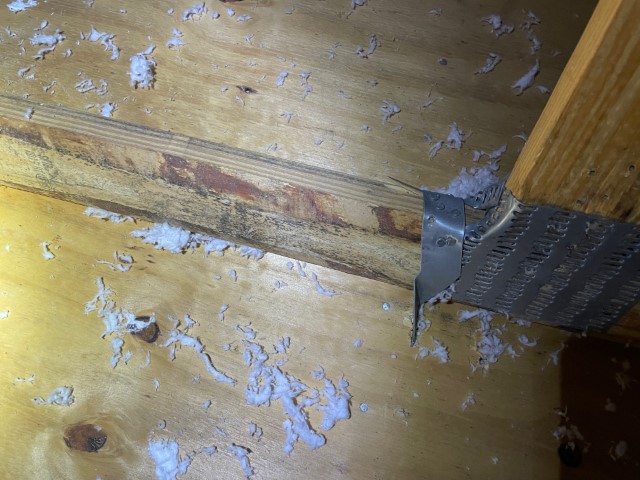
Now:
If the trusses have white spots present, there is more of a chance that the moldy trusses became that way after they were installed in the building envelope.
There are a few different reasons why mildew-looking spots will appear on the roof trusses.
Poor Ventilation
Poor ventilation in an attic space is one of the main causes of mold on roof trusses due to their ability to trap moisture within enclosed spaces. When warm/humid air enters these areas it can lead to condensation which then provides a perfect breeding ground for mold.
Ventilation in an attic has components such as attic insulation and soffit vents. An attic needs to breathe unless it is sealed with foam insulation which is a completely different attic system.
Air Leakage From HVAC Ductwork
Air conditioning ductwork that runs through an attic space carries cool air through them. During the summer months or in warmer clients an attic can get extremely hot. I mean 140 degrees hot!
So if there is a hole in any of the ductwork, cold air can leak. When cold air lands on hot building materials which in this case is the roof trusses it can cause high moisture content leading the mold.
In this particular case, more often than not, the mold will only be on the surface of the truss and not using it as a food source. It will typically appear in white spots that will look like this:
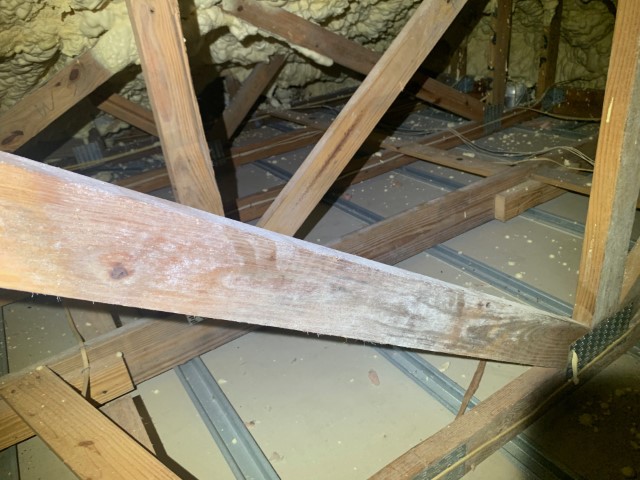
Leaking Roofs
While black-looking mold could mean that the trusses were left in the rain, that is by no means a rule.
Mold will appear black in color when building materials get wet as well.
The most common occurrence of when the timber will get wet is due to a roof leak.
When there is a roof leak, the first line of defense in an attic space is the roof sheathing which is the plywood between the ceiling and the exterior. When a roof leak becomes bad enough, the roof trusses can get wet allowing mold to grow.
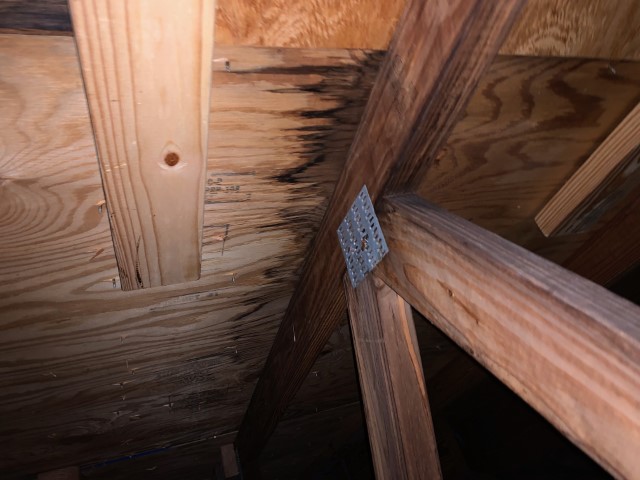
Broken Vents
Broken vents such as dryer vents or bathroom ventilation fans run from the house to the exterior.
If a vent is broken it can lead to air leakage in the attic space which can lead to microbial growth.
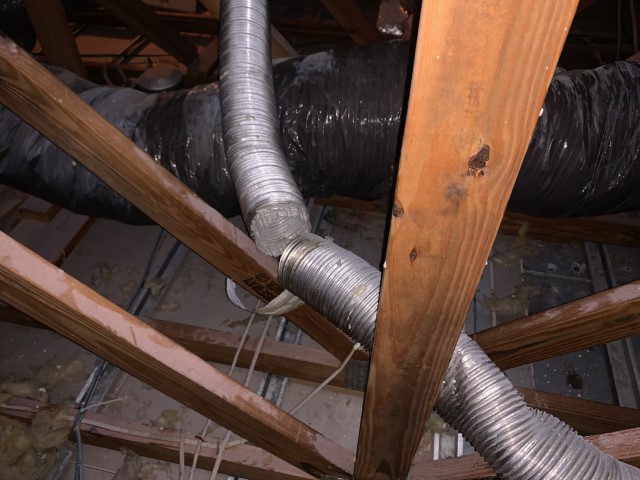
Is Moldy Roof Trusses Dangerous?
More often than not mold growing on wood in the attic is not a major concern. The walls and ceiling in a home kind of encapsulate the mold and keep the spores in the attic space.
However, if there is any air transference from the attic space into the living space the mold spores can cross-contaminate into the living space of the home allowing the occupants to breathe the mold spores into their bodies.
Things can become bleak if there is water damage in the attic because while a leak can start with just the wood holding the house up, the water damage can make it to the interior of the home causing water damage to drywall, floor, and other building materials.
Mycotoxins love drywall more than most other materials so if there is no control of the leak in the attic, it can certainly become a cause for concern.
How to Remove Mold On Roof Trusses
There are multiple ways that mold remediation can be done on roof trusses.
Before mold removal can be done, the cause needs to be identified. A mold inspection can help determine what caused the damage to the wood beams.
Once the source of the damage has been identified and corrected a plan by the contractor or mold remediation specialist will need to be put in place.
Because there may not be much room to move around in an attic, there are sometimes limitations. Heavy equipment such as air scrubbers or dehumidifiers may also prove to be impossible to install during the remediation process.
Unless there is severe water damage, removal of water damaged wood trusses will probably not be done. The structural integrity of the home could be at stake and a licensed structural engineer will need to be consulted.
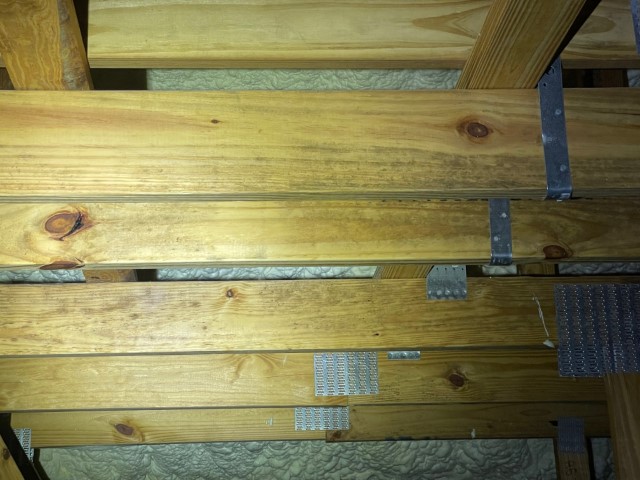
HEPA Vacuuming
HEPA Vacuuming is a one part of the mold remediation process that involves using a special type of vacuum that can remove tiny mold particles from contents.
Sometimes, especially when the mold is white and appears as mildew, just by vacuuming the spores alone will get rid of the mold.
Dry Ice Blasting
A newer process called ice blasting has become popular for removing mold on attic materials. It involves using a blaster with a nozzle and treating the affected area with dry ice.
Encapsulating
Encapsulation involves sealing the moldy trusses with an anti-microbial sealant. This process is usally used in conjunction with HEPA vacuuming.
Preventing Mold on Roof Trusses
Proper Ventilation
The first step is to ensure there is proper ventilation in the attic space. There is a such thing as over-ventilating an attic so the hope is that the builder will have all engineering controls done during the home-building process.
It may be necessary to add some kind of mechanical fan in some situations.
Dehumidifiers
When engineering controls such as soffit ventilation alone does not control the humidity in an attic, a separate dehumidifier may need to be installed.
These units can sometimes be tied into a central air conditioning system or can also be stand-alone units.
Repair Any Leaks
This goes without saying but we’ll say it anyways:
If you have any kind of roof leaks, they need to be corrected IMMEDIATELY!
Rain water can destroy wood organisms.
Moisture content on wood will almost always lead to mold growth. Protecting an environment to ensure wood in the attic doesn’t get wet can not only prevent mold growth on the trusses, but it can prevent mold growth on the ceiling and walls in the home.
Moisture Barriers
Installing a vapor barrier under your roof sheathing helps protect against excessive humidity levels by blocking warm moist air from entering your attic space through small openings like nail holes created when installing shingles on top of your roof decking material . This will help maintain an optimal temperature level within your attic reducing chances for potential condensation buildup which can lead to mold problems down the road if left unchecked over time. Additionally, using fans within this enclosed area also helps circulate air throughout helping reduce overall humidity levels even further.
Pre-Treat Wood Trusses With Borate
The Office of Energy Efficiency and Renewable Energy also recommends treating the roof trusses with borat. Borate is more known for treating wood as an insecticide however it can help prevent fungi as well. Source
Have The HVAC System Regularly Inspected
By having the HVAC system and ductwork regularly checked, there is a lower chance that high humidity can lead to moisture on building materials in the attic leading to growth.
Is it Definitely Mold?
There are times when mold is often confused with something else. Here are a few type of content confused with mold but is not actual fungal growth:
Concrete
During the home construction process a house, there can be a lot going on. There are times where the structural wood beams can come in contact with wet concrete. And as we know, when concrete dries it gets and doesn’t come off easily.
If there is a hard grey surface on the wood it may actually be concrete and not fungal growth
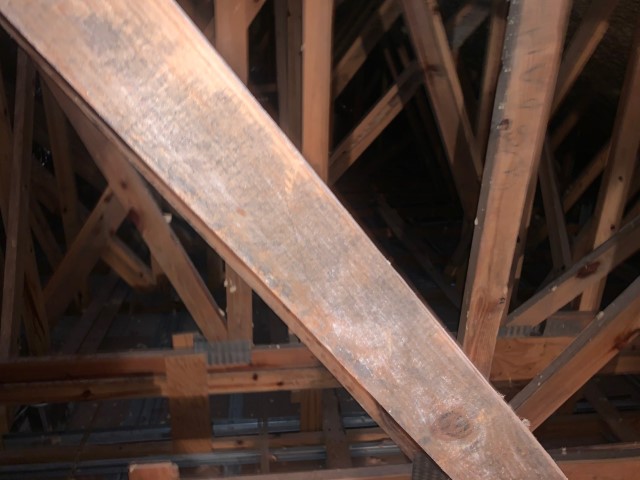
Pesticide
The home builder may also have a pest control company spray a white pesticide in the attic. When this is done the white powder looking substance is typically not just sprayed on the roof trusses but on everything.
If there is a build up on a white powder substance on the insulation, there is a good possibility it’s pesticide and not mold.
The best way to determine if a substance is mold or not is to have it tested by a mold inspector.
Conclusion
Roof trusses are often forgotten about because they are never seen. While in most cases, it’s not a major concern it should also not be taken lightly.
The best way to ensure there is no moldy trusses is to prevent it in the first place. When a home builder is kept in check ensuring that the wood is not left on the ground outside during construction can go a long way.
Attic ventilation and moisture control in the attic are also crucial to ensure an attic system is as mold free as possible.
Explore Related Topics:
Notice an update we should make?
We strive for accuracy. Contact us here if you see incorrect or outdated info on this page.

